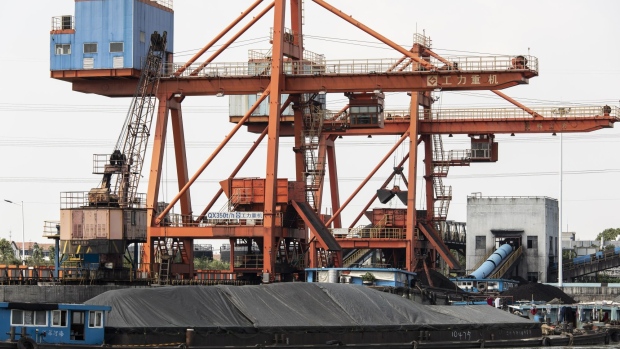Oct 13, 2021
China Raises Coal and Gas Imports to Counter Energy Crisis
, Bloomberg News

(Bloomberg) -- China’s energy crunch pulled in more coal and gas imports in September, as buyers scrambled to ensure adequate supplies to counter a deepening power shortage ahead of peak winter demand.
Coal purchases rose 17% on the month to 32.9 million tons, the highest total this year, according to the customs administration on Wednesday, although the tally for the first nine months still lags last year’s pace.
Coal imports have been constrained as top supplier Indonesia prioritizes its domestic needs. Covid-restrictions in Mongolia have also affected overland shipments, and China continues to push its neighbor for more supply to ease a shortage that sent futures rocketing to yet another record on Wednesday.
Gas purchases could only nudge up 1.8% to 1.06 million tons, as sky-high prices and a shortage on international markets affected buyers’ ability to secure enough shipments, although imports of the cleaner-burning fuel are still running 22% ahead of last year.
China’s import prospects and policies, including its yearlong ban on Australian coal, will doubtless be a hot topic when the government briefs on the energy crisis later Wednesday in Beijing. The event includes officials from the National Development and Reform Commission -- China’s top planning agency -- the National Energy Administration and State Grid Corp.
Elsewhere in the trade data, crude imports fell as inclement weather and a resurgent virus stalled purchases, while soybean imports plunged after Hurricane Ida snarled cargoes from the U.S.
Among metals, copper imports showed only a modest increase, despite power rationing and cuts to domestic production, due to the global container shortage and port congestion affecting South American and African suppliers. Iron ore purchases slipped as demand was hurt by output cuts at steel mills.
More broadly, China’s export growth accelerated in September, defying expectations of a slowdown amid the nationwide power crunch that has forced factories to cut production. Import growth softened as domestic demand weakened.
Events Today
- China Sept. aggregate financing & money supply due from today
- Chinese govt briefs on energy crisis in Beijing, 15:00
- UN Biodiversity Conference in Kunming, day 3
- LME Week in London
Today’s Chart
Flooding in China’s key mining regions could deepen the economy’s slowdown, says Bloomberg Economics. Shanxi and Shaanxi provinces are modest in terms of economic clout, but punch above their weight in coal output.
On The Wire
China’s economic slowdown is putting the spotlight back on fiscal stimulus -- but Beijing isn’t opening the spending taps just yet.
China’s power crunch drove the gap between producer and consumer price inflation even wider in September, according to high-frequency data tracked by Bloomberg Economics.
- LNG Deliveries From China’s Guangdong Halted on Typhoon Kompasu
- China Plate Glass Price Surge Led to Property Project Delay:CCTV
- China Media Warn of Pressure on Property; Vocational Study Plans
- Steady Consumption Recovery Likely in China’s Golden Week: CICC
- China Soy Sauce King Raises Sales Prices, Citing Cost Inflation
- Australian Exporters Hit by China Found New Markets: Frydenberg
- EV Battery’s Road to $58/kWh Hamstrung by Power, Metals Shortage
- Silvercorp Discovers New Gold Vein Structures at DCG Mine
- London Metal Exchange Details ESG Disclosures of Nine Producers
The Week Ahead
Thursday, Oct. 14:
- China inflation data for September, 09:30
- UN Biodiversity Conference in Kunming, day 4
- Hong Kong holiday
- USDA weekly crop export sales, 08:30 EST
- LME Week in London
Friday, Oct. 15:
- Rio Tinto quarterly production report
- China sets monthly 1-Year Medium-term Lending Facility rate
- China weekly iron ore port stockpiles
- Shanghai exchange weekly commodities inventory, ~15:30
- UN Biodiversity Conference in Kunming, day 5
- EARNINGS: Zijin Mining
- LME Week in London
©2021 Bloomberg L.P.


